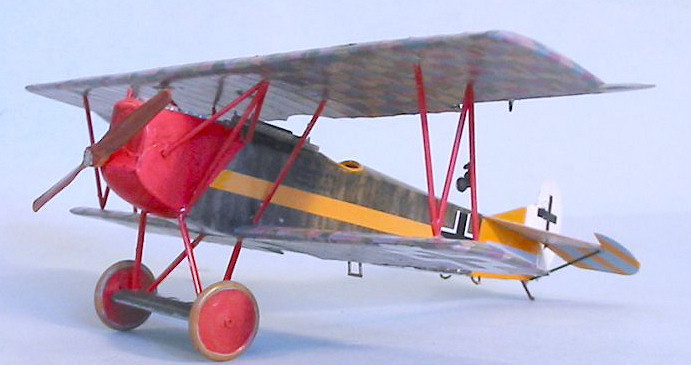
| KIT: | Eduard 1/48 Fokker D.VII (early) |
| KIT #: | ? |
| PRICE: | $34.95 MSRP |
| DECALS: | Four options |
| REVIEWER: | Tom Cleaver |
| NOTES: | Comes with complete lozenge decals and rib tapes |

| HISTORY |
Once Anthony Fokker won the First Fighter Competition in 1918, the Fokker factory received an immediate order for 200 D.VIIs. As production of these aircraft began, the demand was so great to replace the obsolescent Albatros D.Vs, Pfalz D.IIIs and the Fokker Dr.I with this excellent new fighter that Fokker was directed by the Fliegerabteilung to license production of the airplane by Albatros. For Fokker, whose products had been so often beaten by Albatros over the two previous years, such an arrangement was the best kind of revenge, the kind that makes money. Albatros obtained a license in February 1918 for both the original factory and the Ostdeutsche Albatros Werke (OAW)factory in Schneidenmuehl in the state of Silesia. Over half of all production of the D.VII between March 1918 and the end of the war came from the Albatros and OAW factories.
Originally, the Mercedes D.III engine was closely-cowled with the exhaust inside
the cowling, which led to overheating that could be so severe as to “cook off”
the ammunition in the tanks immediately to the rear of the engine firewall, and
led to later-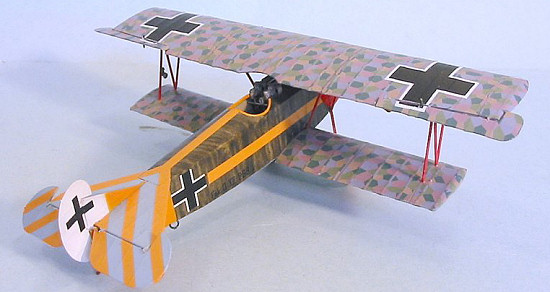 production D.VIIs having numerous louvers in the cowling to aid
cooling. The first 200 Fokker-built D.VIIs were visually distinguishable by
their fuselage, which was painted in the traditional Fokker “streaky”
camouflage, while the wings and tail surfaces were covered with a 5-color
lozenge fabric only used by the Fokker factory with the rib tapes also done with
strips of lozenge fabric.
production D.VIIs having numerous louvers in the cowling to aid
cooling. The first 200 Fokker-built D.VIIs were visually distinguishable by
their fuselage, which was painted in the traditional Fokker “streaky”
camouflage, while the wings and tail surfaces were covered with a 5-color
lozenge fabric only used by the Fokker factory with the rib tapes also done with
strips of lozenge fabric.
Willi Gabriel:
Willi Gabriel and his twin brother Walter were both interested in aviation as youths. They built their own airplane in 1912 at the age of 19 and managed to fly it. Both joined the Army shortly after the outbreak of war and received flight training in 1915, and both became observation pilots, rising to the rank of Obergefreiter, or Master Sergeant. Walter managed a short career as a fighter pilot in early 1917, though he transferred back to observation flying and was shot down on August 19, 1917, becoming a POW. Willi had transferred to ground attack, flying the Halberstadt Cl.II with Schlact Staffel 15, where he established a reputation for being cool under fire. He and his gunner shot down a SPAD in March, 1918, and he took the opportunity to personally as Manfred von Richtofen for a transfer to JG 1. His commander in Schlasta 15 blocked it, but Gabriel was persistent. On May 19, 1918, Gabriel walked across the field from his unit to the elite Jasta 11, formerly commanded by Manfred von Richtofen, on May 19, 1918. Upon arrival, Geschwader commander Wilhelm Reinhard informed him that “If within four weeks you do not obtain an aerial victory, you will be shipped back to your original unit.”
Later that same day, Gabriel talked himself onto the evening patrol and scored his first victory, a de Havilland D.H.9 bomber from 49 Squadron. During June Gabriel destroyed two balloons and shot down 2 fighters to bring his score stood at 8, developing a reputation as a lone wolf.
Reinhard was killed in a flying accident at Adlershof on June 3, 1918, while
test-flying the Zeppelin-Landau D.I. Reinhard had allowed experienced pilots in
the unit to make lone patrols, but his replacement was Oberleutnant Hermann
Goering from Jasta 27, who (rightly) insisted that air combat in the summer of
1918 had no place for the lone wolf fighter pilot. Gabriel already had a
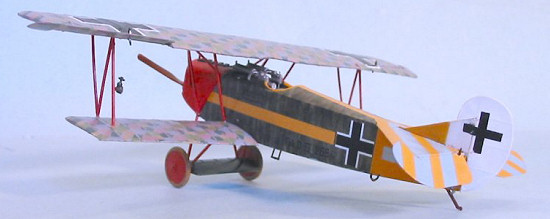 reputation as a “troublemaker” for not allowing Reinhard to claim a SPAD both
had shot at on June 12. This would have been Reinhard’s 20th victory,
which would have meant the award of the Pour le Merite. Karl Bodenschatz
managed to convince Gabriel that the next two “shared” victories would be given
him if he gave in on this, which he did reluctantly just before Reinhard left
for Adlershof, where he was killed.
reputation as a “troublemaker” for not allowing Reinhard to claim a SPAD both
had shot at on June 12. This would have been Reinhard’s 20th victory,
which would have meant the award of the Pour le Merite. Karl Bodenschatz
managed to convince Gabriel that the next two “shared” victories would be given
him if he gave in on this, which he did reluctantly just before Reinhard left
for Adlershof, where he was killed.
While returning from a morning patrol led by Goering on July 18, Gabriel left the flight and after spotting a formation of French SPADS attacked And shot down two of them. Returning to base he came across a formation of three Breguet XIVs and shot down one a kilometer from his base. When he landed, Goering ordered him to confirm his kill of a SPAD. Having not seen this, Gabriel refused and Goering gave him a direct order not to fly alone again. That afternoon, Gabriel again left his flight and shot down a French 2-seater SPAD. Upon his return, Goering sent him on a 4-week leave. When he returned on August 20, Goering sent him as a test pilot to an air park. Gabriel did not fly combat again during the war.
Gabriel continued flying after the war, and rejoined the new Luftwaffe in 1935. In 1938 flew a Fokker Dr.I and a D.VII in two movies about World War I aviation. During the Second World War he rose to the rank of Hauptmann, flying Ju-88s and Me-410s.
Gabriel’s first D.VII became famous in the 1960s due to his willingness to provide photographs and descriptions of the markings to World War I aviation historian Alex Imrie. His account of his difficulties as an NCO pilot in JG 1 formed the basis for the character played by George Peppard in the movie “The Blue Max.”
| THE KIT |
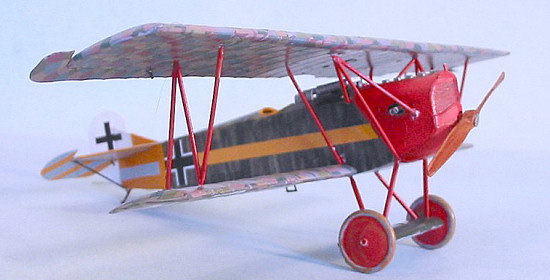 The
most-common version of the Fokker D.VII produced in model form has been the
BMW-powered D.VIIf, which was the least-produced version of the real thing.
Thus, modelers who wanted to do the other versions were forced to either modify
the cowls of the Monogram or DML kits themselves, or use some cottage-industry
resin replacements. It was only with the introduction of the Roden D.VIIs in
both 1/72 and 1/48 scale that an effort was made to create these different
versions. Roden’s choice was to make the engine cowling separate from the
fuselage, breaking it at the firewall.
The
most-common version of the Fokker D.VII produced in model form has been the
BMW-powered D.VIIf, which was the least-produced version of the real thing.
Thus, modelers who wanted to do the other versions were forced to either modify
the cowls of the Monogram or DML kits themselves, or use some cottage-industry
resin replacements. It was only with the introduction of the Roden D.VIIs in
both 1/72 and 1/48 scale that an effort was made to create these different
versions. Roden’s choice was to make the engine cowling separate from the
fuselage, breaking it at the firewall.
Eduard announced at the outset that their 1/48 series of D.VIIs would include the different cowlings integral to the fuselage halves. This actually makes for a more expensive kit, since the fuselage sprues differ from kit to kit. This particular kit has fuselage halves that depict both the first and fourth production runs of Fokker-built D.VIIs, with different cowlings.
Where Roden’s kit has a complete interior, including parts like the gas tank and the forward gun boxes which cannot be seen when the model is completed regardless of whether it is assembled with an open or closed cowling, this Eduard kit only supplies those parts that can be seen when the model is completely assembled. The Eduard kit does not provide the modeler with the opportunity of assembling the model with the engine compartment open, as the Roden kit does.
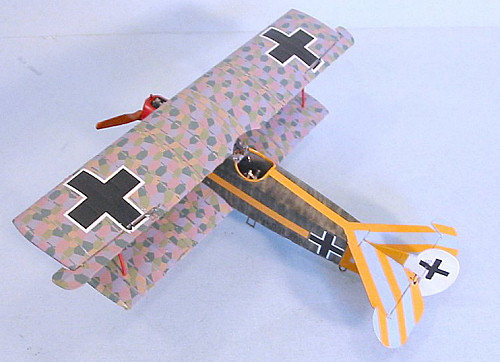 Where the Roden kit provides the wings and tail surfaces with a restrained
fabric effect that is the closest to accurate of any World War I model, the
Eduard kit has a heavier surface detail with overdone rib tapes, much like has
appeared on their Sopwith Camel and Bristol Fighter kits. However, the Eduard
kit has a much less “fiddly” construction method for the wings, without the
separate wingtip caps that the Roden kit has. Also, the wings do not look bad
once the lozenge decals have been applied.
Where the Roden kit provides the wings and tail surfaces with a restrained
fabric effect that is the closest to accurate of any World War I model, the
Eduard kit has a heavier surface detail with overdone rib tapes, much like has
appeared on their Sopwith Camel and Bristol Fighter kits. However, the Eduard
kit has a much less “fiddly” construction method for the wings, without the
separate wingtip caps that the Roden kit has. Also, the wings do not look bad
once the lozenge decals have been applied.
The Eduard kit supplies sufficient lozenge decal to completely cover the model - in either the early 5-color or later 4-color lozenge - with the various pieces pre-cut to the proper size for their location. While the printing is not as sharp as other lozenge decals provided by other companies, this pre-cut sheet will be much easier to use for the modeler making a first venture into building a World War I model with lozenge fabric.
In comparison with the Roden kit, the wings of the Eduard kit are not as thick and the profile taper is not as pronounced. After studying lots of photos of D.VIIs, I am unable to state definitively which kit has the more accurate wings, though both are better than either the Monogram (completely inaccurate) or DML kits.
| CONSTRUCTION |
In terms of kit design, the Eduard D.VII is as close to a Tamiya “shake ‘n’ bake” kit as a World War I model can be. All the parts are crisply molded and flash-free, and there is no problem with fit anywhere in the construction process. The control surfaces are all separate, allowing the modeler to pose them in a realistic fashion. I will remind you that if you do that, it is important to pose the controls in the cockpit in such a position that would result with the way the external control surfaces are posed.
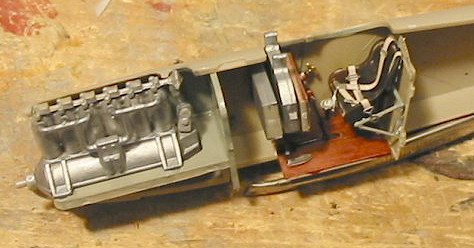 Construction of the model starts with the fuselage. Where assembling the
cowling and positioning the engine is fiddly with the Roden kit, it was
exceedingly simple with the Eduard model. The same was true with the cockpit
interior, and it is virtually impossible to mis-assemble anything here. The
provision of a photo-etch instrument panel with pre-painted instrument faces and
an accurate seat belt is nice.
Construction of the model starts with the fuselage. Where assembling the
cowling and positioning the engine is fiddly with the Roden kit, it was
exceedingly simple with the Eduard model. The same was true with the cockpit
interior, and it is virtually impossible to mis-assemble anything here. The
provision of a photo-etch instrument panel with pre-painted instrument faces and
an accurate seat belt is nice.
Assembly of the wings is easy, and attachment of the lower wing to the fuselage does not include the fiddling necessary with the Roden kit to insure that the profile taper is correct (tapering up on the lower surface and horizontal on the upper surface). I also particularly liked the separate lace part for the lower fuselage, which solves the usual problem of hiding the centerline seam. Fit overall was good enough that I only used Mr. Surfacer on the upper fuselage seam.
I left the model in sub-assemblies of wings, fuselage, and tail surfaces, for painting and decaling before proceeding to final assembly.
| COLORS & MARKINGS |
Painting:
Gabriel’s first D.VII was one of the early Fokker-built machines with the “streaky” camouflage. I first painted the lower fuselage and the rear of the fuselage sides with Xtracrylix RLM65 light blue, which I also used for the horizontal stabilizer and elevators. When this was dry, I masked off the blue stripe on the rear fuselage side, then painted the upper fuselage with Tamiya Buff. I followed this with Tamiya “Dark Green” which was airbrushed to achieve the “streaky” camouflage, while the cowling was completely painted dark green.
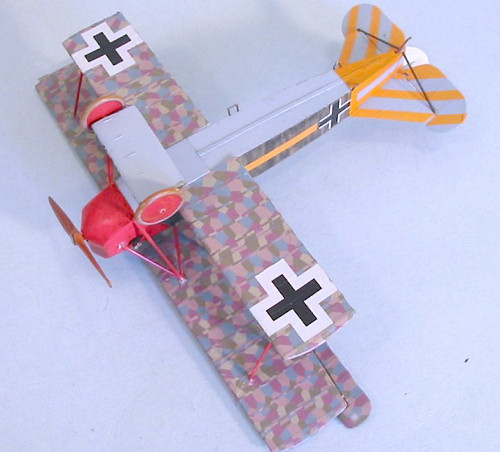 When
all this was dry, I painted the cowling, wheels and struts with Xtracrylix
“German Red,” which ended up darker over the cowling as it would have been on
the original being painted over this dark color. I masked the rear fuselage and
painted that with Gunze-Sangyo “Orange-Yellow,” which was close to a dead-on
match for the orange used in the decal stripes and also let a bit of the
undersurface color through for a more accurate look.
When
all this was dry, I painted the cowling, wheels and struts with Xtracrylix
“German Red,” which ended up darker over the cowling as it would have been on
the original being painted over this dark color. I masked the rear fuselage and
painted that with Gunze-Sangyo “Orange-Yellow,” which was close to a dead-on
match for the orange used in the decal stripes and also let a bit of the
undersurface color through for a more accurate look.
Decals:
Doing lozenge decals is complicated and time consuming. Here, the fact that the various pieces of lozenge were already the right size made things much easier.
I applied the bottom color first, then when it was fully set overnight, the upper color, which also set overnight. I then took all the left-over 5-color lozenge and sliced it up to make the lozenge-colored rib tapes used on early Fokkers. The process is time-consuming, but the result is excellent.
I then applied the stripe decals for the tail surfaces, as well as the stripes on the fuselage. I then applied the kit decals for various stenciling, and the national insignia. The Eduard decals presented no problem with application.
When all the decals were done, the model was given an overall coat of Xtracrylix Satin Varnish.
| FINAL CONSTRUCTION |
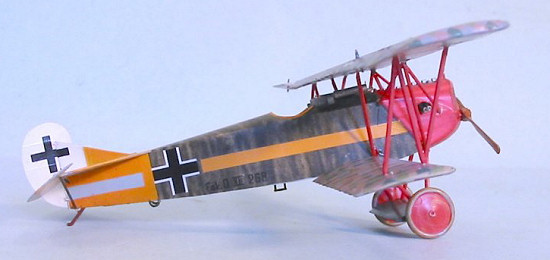 I
attached the control horns to the various control surfaces and then attached
ailerons, elevators and rudder to the wings, horizontal stabilizer and vertical
fin. I also attached the machine guns - I must add here that the Roden guns are
superior in look to those by Eduard, even with the use of the photo-etch
details.
I
attached the control horns to the various control surfaces and then attached
ailerons, elevators and rudder to the wings, horizontal stabilizer and vertical
fin. I also attached the machine guns - I must add here that the Roden guns are
superior in look to those by Eduard, even with the use of the photo-etch
details.
The tripod cabane struts are nice because they are molded in such a way that they will only fit right when they are “right,” which makes assembly easy. Once the cabane struts had set up, I attached the interplane “N” struts, and then attached to top wing. Eduard provides a lot of very small photo-etched parts to do the various attachment plates of struts to wings. I managed to lose a few of these when dropped them onto the carpet, and decided not to worry further about that. A modeler who takes the time to use all these will end up with a very good-looking model in terms of small detail. I then attached the landing gear sub-assembly and proceeded to attach the tail surfaces, lift handles, stirrup step, and prop.
| CONCLUSIONS |
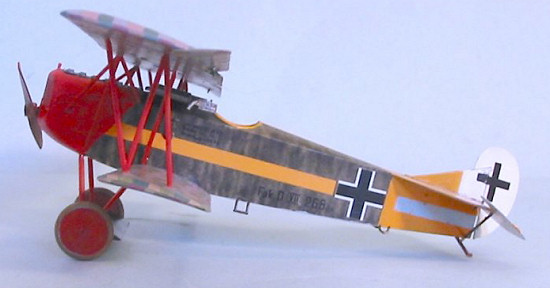 This
is easily the best-designed D.VII kit ever, and is so easy to assemble - and so
difficult to assemble wrong (but never say “never”) - that I unhesitatingly
recommend it to those who have never built a World War I biplane model before.
The original D.VII was said to “make the average pilot good and the good pilot
great,” and this kit will do the same for the modeler who builds it. The
lozenge decals may not be accurate color-wise, but they are a good introduction
to doing this kind of decal work.
This
is easily the best-designed D.VII kit ever, and is so easy to assemble - and so
difficult to assemble wrong (but never say “never”) - that I unhesitatingly
recommend it to those who have never built a World War I biplane model before.
The original D.VII was said to “make the average pilot good and the good pilot
great,” and this kit will do the same for the modeler who builds it. The
lozenge decals may not be accurate color-wise, but they are a good introduction
to doing this kind of decal work.
Even with all that said, the Eduard kit in no way replaces the Roden kit on any terms other than the far greater ease of assembly. Given that the Roden kit is less than half the cost of this kit, anyone who plans to do more than one D.VII (they’re like Bf-109s when it comes to a wide variety of interesting and available markings on aftermarket sheets) will likely consider trading the additional time spent assembling the cheaper Roden kit against the increased cost of the Eduard.
With this series of Fokker D.VII kits and the earlier Camels and Bristol Fighter, Eduard definitely is now the “Tamigawa” of World War I models.
February 2006
Thanks to Eduard for the review kit.
If you would like your product reviewed fairly and quickly by a site that has over 300,000 visitors a month, please contact me or see other details in the Note to Contributors.